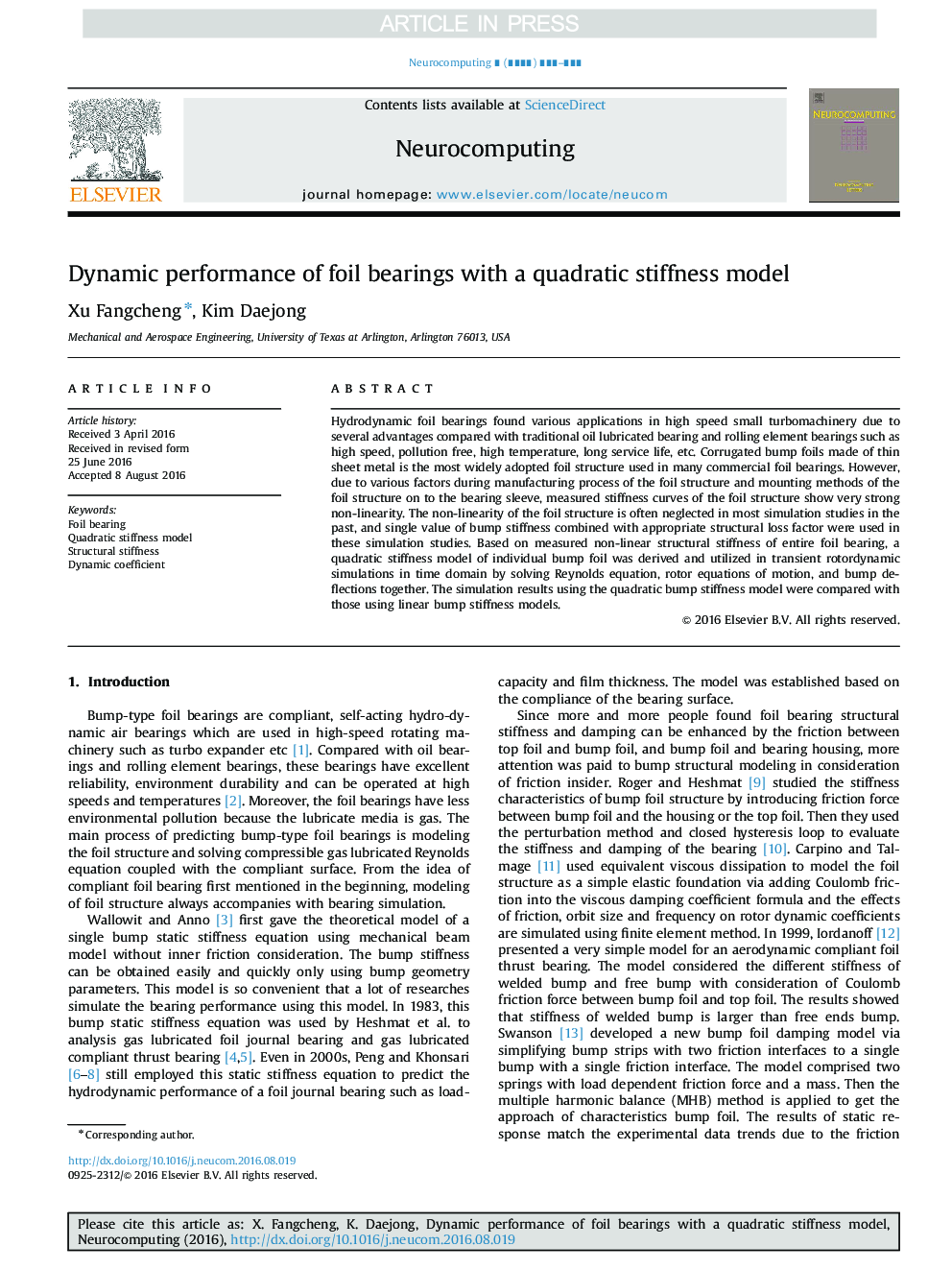| کد مقاله | کد نشریه | سال انتشار | مقاله انگلیسی | نسخه تمام متن |
|---|---|---|---|---|
| 4948380 | 1439611 | 2016 | 6 صفحه PDF | دانلود رایگان |
عنوان انگلیسی مقاله ISI
Dynamic performance of foil bearings with a quadratic stiffness model
ترجمه فارسی عنوان
عملکرد دینامیکی یاتاقان فویل با مدل سختی درجه دوم
دانلود مقاله + سفارش ترجمه
دانلود مقاله ISI انگلیسی
رایگان برای ایرانیان
کلمات کلیدی
فویل بلبرینگ، مدل سختی دو طرفه، سختی سازه، ضریب پویا
ترجمه چکیده
بلبرینگ هیدرودینامیکی فویل با استفاده از چندین مزیت در مقایسه با روغن های معمولی و غلتک های عادی مانند سرعت بالا، بدون آلودگی، درجه حرارت بالا، عمر طولانی و غیره، از کاربرد های مختلف در توربوماچین کوچک با سرعت بالا برخوردار است. سازه فویل به طور گسترده تر مورد استفاده در بسیاری از فویل های تجاری فویل است. با این حال، با توجه به عوامل مختلف در طول فرایند تولید از ساختار فویل و روش نصب از ساختار فویل بر روی آستین تحمل، منحنی سختی اندازه گیری از ساختار فویل نشان می دهد غیر خطی بسیار قوی است. غالبا خطی بودن ساختار فویل در بیشتر مطالعات شبیه سازی در گذشته غفلت شده است و تنها ارزش سختی ضربه با فاکتور ضعیف ساختاری مناسب در این مطالعات شبیه سازی مورد استفاده قرار گرفته است. بر اساس سختی ساختاری غیر خطی ساختار کل فویل، یک مدل سختی درجه دوم فویل انفجاری فردی، با حل معادلات رینولدز، معادلات روتور حرکت و انحرافات کمان با استفاده از شبیه سازی های فتوولتائینامیکی گذرا در حوزه زمان، به دست می آید. نتایج شبیه سازی با استفاده از مدل استحکام ضربه دوم درجه دوم با آنهایی که با استفاده از مدل های سخت گیر خطی مقایسه شده مقایسه شدند.
موضوعات مرتبط
مهندسی و علوم پایه
مهندسی کامپیوتر
هوش مصنوعی
چکیده انگلیسی
Hydrodynamic foil bearings found various applications in high speed small turbomachinery due to several advantages compared with traditional oil lubricated bearing and rolling element bearings such as high speed, pollution free, high temperature, long service life, etc. Corrugated bump foils made of thin sheet metal is the most widely adopted foil structure used in many commercial foil bearings. However, due to various factors during manufacturing process of the foil structure and mounting methods of the foil structure on to the bearing sleeve, measured stiffness curves of the foil structure show very strong non-linearity. The non-linearity of the foil structure is often neglected in most simulation studies in the past, and single value of bump stiffness combined with appropriate structural loss factor were used in these simulation studies. Based on measured non-linear structural stiffness of entire foil bearing, a quadratic stiffness model of individual bump foil was derived and utilized in transient rotordynamic simulations in time domain by solving Reynolds equation, rotor equations of motion, and bump deflections together. The simulation results using the quadratic bump stiffness model were compared with those using linear bump stiffness models.
ناشر
Database: Elsevier - ScienceDirect (ساینس دایرکت)
Journal: Neurocomputing - Volume 216, 5 December 2016, Pages 666-671
Journal: Neurocomputing - Volume 216, 5 December 2016, Pages 666-671
نویسندگان
Xu Fangcheng, Kim Daejong,
